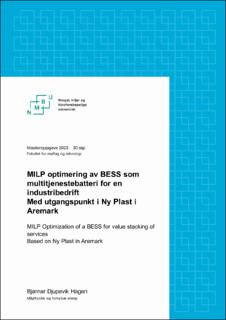| dc.contributor.advisor | Heidi Nygård Samuelsen | |
| dc.contributor.advisor | Alexander Finn | |
| dc.contributor.author | Hagen, Bjørnar Djupevik | |
| dc.date.accessioned | 2024-04-10T16:27:31Z | |
| dc.date.available | 2024-04-10T16:27:31Z | |
| dc.date.issued | 2024 | |
| dc.identifier | no.nmbu:wiseflow:6981401:56743811 | |
| dc.identifier.uri | https://hdl.handle.net/11250/3125888 | |
| dc.description.abstract | Hovedspørsmålet i denne oppgaven er hvilke insentiver en bedrift har for å kjøpe og
installere en battericontainer (BESS) som et multi-tjenestebatteri, og hvordan batteri-
et bør drives og hvilke tjenester det også tilfører en BRP. For å kunne besvare denne
problemstillinger, ble det laget en MILP modell for å finne den optimale driften av en
BESS ved å maksimere profitt med å kombinere tilgjengelige tjenester. Tjenestene inklu-
derer implisitt fleksibilitet som lastflytting, reduksjon av effektopper og prisarbitrasje
i tillegg til eksplisitte fleksibilitetstjenester som deltakelse i FFR, FCR-N og mFRR.
Batteridegradering er ikke inkludert i oppgaven eller modellen.
Med utgangspunkt i bedriften Ny Plast i Aremark som har 190 kWP eak solcelleanlegg
og en BESS på 1,1 MWh / 1 MW har det blitt vist at besparelsene i strømregningen
kan være opp til omkring 450 000 - 1 000 000 kroner i året sammenlignet mot å ikke
gjøre noen tiltak. Dette er beregnet uten inkluderingen av kostnader til en aggregator.
Denne analysen viser at det alltid lønner seg å delta i FFR Profil. Inntektene fordeler
seg omtrent likt mellom implisitte og eksplisitte fleksibiltetstjenester. Fra BRP’en sin
side, ble det funnet at BESSen bør delta i balansemarkedene nærmere to tredjedeler av
tiden, som antyder attraktive markeder. | |
| dc.description.abstract | The main question in this thesis is what incentives a company has to buy and install a
battery energy storage system (BESS) as a multi-service battery, and how the battery
should be operated, and what services it provides to a BRP. To answer these questions,
a MILP model was created to find the optimal operation of a BESS by maximizing
profit by combining available services. The services include implicit flexibility such as
load shifting, peak shaving and price arbitrage, in addition to explicit flexibility services
such as participation in FFR, FCR-N and mFRR. Battery degradation is not included
in this thesis or MILP model.
Based on the company Ny Plast in Aremark, which has a 190 kWP eak solar PV system
and a BESS of 1.1 MWh / 1 MW, it has been shown that the savings in electricity
bills can be up to around NOK 450,000 - 1,000,000 per year compared to not taking
any measures. This is calculated without the inclusion of costs to an aggregator. This
analysis shows that it always pays to participate in FFR Profile. Revenues are roughly
split equally between implicit and explicit demand response services. From the BRP’s
point of view, it was found that the BESS should participate in the balancing markets
close to two thirds of the time, which suggests attractive markets. | |
| dc.language | nob | |
| dc.publisher | Norwegian University of Life Sciences | |
| dc.title | MILP optimering av BESS som multitjenestebatteri for en industribedrift Med utgangspunkt i Ny Plast i Aremark | |
| dc.type | Master thesis | |
